 W
WLand art, variously known as Earth art, environmental art, and Earthworks, is an art movement that emerged in the 1960s and 1970s, largely associated with Great Britain and the United States but also includes examples from many countries. As a trend, "land art" expanded boundaries of art by the materials used and the siting of the works. The materials used were often the materials of the Earth, including the soil, rocks, vegetation, and water found on-site, and the sites of the works were often distant from population centers. Though sometimes fairly inaccessible, photo documentation was commonly brought back to the urban art gallery.
 W
WA geoglyph is a large design or motif produced on the ground and typically formed by clastic rocks or similarly durable elements of the landscape, such as stones, stone fragments, gravel, or earth. A positive geoglyph is formed by the arrangement and alignment of materials on the ground in a manner akin to petroforms, while a negative geoglyph is formed by removing part of the natural ground surface to create differently coloured or textured ground in a manner akin to petroglyphs.
 W
W7000 Oaks – City Forestation Instead of City Administration is a work of land art by the German artist Joseph Beuys. It was first publicly presented in 1982 at the documenta 7.
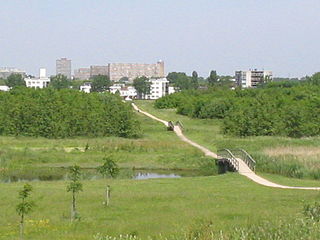 W
WThe Abtswoudse Bos is man-made park and land art project, opened in 2000, of about 190 ha. It lies south of the Tanthof neighbourhood in Delft, east of Schipluiden and north of Overschie.
 W
WThe Blythe Intaglios or Blythe Geoglyphs are a group of gigantic figures incised on the ground near Blythe, California, in the Colorado Desert. The ground drawings or geoglyphs were created by humans for an, as yet, unknown reason.
 W
WThe Caseros Prison Demolition Project — 80,000 Tons, which contains 16 Tons and Aparecidos, is the work of artist Seth Wulsin. It uses the defunct Caseros Prison of Buenos Aires, Argentina and its demolition as raw materials.
 W
WThe Center for Land Use Interpretation (CLUI) is a non-profit research and education organization involved in exploring, examining, and understanding contemporary landscape issues in the United States. Founded in 1994, the CLUI organizes exhibitions, programs, field trips, and maintains an online archive and database to engage the public's understanding of the man-made landscape, and extent and impacts of human interactions with the surface of the earth. The Center employs a variety of methods to this end, engaging in research, classification, extrapolation, and exhibition.
 W
WCity is an earth art sculpture located in Garden Valley, a desert valley in rural Lincoln County in the U.S. state of Nevada, near the border with Nye County. The work was begun in 1972 by the artist Michael Heizer and is ongoing. When complete, it will be one of the largest sculptures ever built.
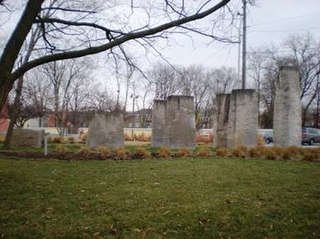 W
WConfluence is a land art sculpture by artists Robert Stackhouse and Carol Mickett. The work sits on the grounds of the Indianapolis Art Center located in Indianapolis, Indiana, United States. Confluence was installed as part of the Art Center's ARTSPARK initiative.
 W
WCrawick Multiverse is a land art project by the landscape architect and designer Charles Jencks near Sanquhar, Dumfries and Galloway. It opened to the public on 21 June 2015. The project is located on the site of a former open cast coal mine and covers approximately 55 acres, making it the largest of Jencks' works in Britain. Nine 'landforms' make up the Crawick Multiverse. Like Jencks' other work, including the nearby Garden of Cosmic Speculation, these represent ideas from modern cosmology. Unlike the Garden of Cosmic Speculation, the Crawick Multiverse landforms use stone, in the style of the megalithic monuments. These include the 'North-South Line', a 400 meter long stone avenue flanked by over 300 boulders, and two stone circles on top of mounds representing the Milky Way and Andromeda galaxies. In total, over 2000 boulders have been used in the project. Jencks has described it as "A cosmic landscape worthy of the ancients."
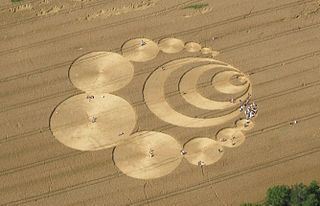 W
WA crop circle, crop formation, or corn circle is a pattern created by flattening a crop, usually a cereal. The term was first coined in the early 1980s by Colin Andrews. Crop circles have been described as all falling "within the range of the sort of thing done in hoaxes" by Taner Edis, professor of physics at Truman State University. Although obscure natural causes or alien origins of crop circles are suggested by fringe theorists, there is no scientific evidence for such explanations, and all crop circles are consistent with human causation.
 W
WDesert Lighthouse is a full-size functioning lighthouse in the Mojave Desert near Hinkley, California, United States. It was built in 2017 by artist Daniel Hawkins after nearly 10 years of planning and unexpected setbacks.
 W
WDouble Negative is a piece of land art located in the Moapa Valley on Mormon Mesa near Overton, Nevada. Double Negative was created in 1969 by artist Michael Heizer.
 W
WEarl W. Brydges Artpark State Park is a 108-acre (0.44 km2) state park located in the Village of Lewiston in Niagara County, New York. The park, which is officially named after former New York State Senator Earl Brydges, is generally referred to as Artpark. The park overlooks the Niagara Gorge.
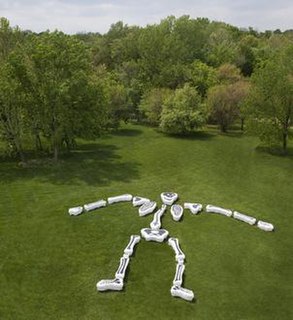 W
WFunky Bones is a public artwork by Atelier Van Lieshout, a Dutch artist collective led by Joep van Lieshout, located in the 100 Acres: The Virginia B. Fairbanks Art and Nature Park, which is on the grounds of Newfields in Indianapolis, Indiana, United States. The artwork, primarily made from fiberglass, consists of twenty white and black bone-shaped benches.
 W
WThe Garden of Cosmic Speculation is a 30 acre sculpture garden created by landscape architect and theorist Charles Jencks at his home, Portrack House, in Dumfriesshire, Scotland. Like much of Jencks' work, the garden is inspired by modern cosmology.
 W
WThe Green Cathedral or De Groene Kathedraal located near Almere, the Netherlands, is an artistic planting of Lombardy poplars that mimics the size and shape of the Cathedral of Notre-Dame, Reims, France. The Green Cathedral is 150 m (490 ft) long and 75 m (246 ft) wide, and the mature poplar trees are about 30 m (98 ft) tall.
 W
WThe Irish Hunger Memorial is a 0.5-acre (0.20 ha) park at the corner of Vesey Street and North End Avenue in the Battery Park City neighborhood of Manhattan in New York City — dedicated to raising awareness of the Great Irish Hunger, referred to as An Gorta Mór in Irish, in which over one million starved to death between 1845 and 1852 as a result of British policies that prioritized the exportation of profitable foods as most of the potato crop was wiped out by a fungus like organism called Phytophthora infestans.
 W
WJupiter Artland is a contemporary sculpture park and art gallery in Edinburgh, Scotland. Jupiter Artland Foundation is a registered charity that is subsidized by classes, workshops, events, ticket sales, and donations.
 W
WKeyboard Monument is an outdoor sculpture featuring the QWERTY/JCUKEN keyboard. It is located in the Russian city of Yekaterinburg alternatively spelt Ekaterinburg and is popular among tourists.
 W
WIn Greek mythology, the Labyrinth was an elaborate, confusing structure designed and built by the legendary artificer Daedalus for King Minos of Crete at Knossos. Its function was to hold the Minotaur, the monster eventually killed by the hero Theseus. Daedalus had so cunningly made the Labyrinth that he could barely escape it after he built it.
 W
WThe Laguna Canyon Project (1980–2010), a long-term environmental art project, used a variety of tactics and techniques to focus attention on the bucolic Laguna Canyon Road, one of the last undeveloped passages to the Pacific Ocean. The project, created by photographic artists Jerry Burchfield and Mark Chamberlain, was a response to explosive growth in south Orange County and especially to the threats of development within their hometown of Laguna Beach, California. What began as a 10-year project lasted for three decades.
 W
WThe Marree Man, or Stuart's Giant, is a modern geoglyph the circumstances of whose creation have not been ascertained. It appears to depict an Indigenous Australian man hunting with a boomerang or stick. It lies on a plateau at Finnis Springs 60 km (37 mi) west of the township of Marree in central South Australia. It is just outside the 127,000-square-kilometre (49,000 sq mi) Woomera Prohibited Area. The figure is 2.7 km (1.7 mi) tall with a perimeter of 28 km (17 mi), extending over an area of about 2.5 km2. Although it is one of the largest geoglyphs in the world, its origin remains a mystery, with no one claiming responsibility for its creation nor any eye-witness having been found, notwithstanding the scale of the operation required to form the outline on the plateau floor. The description "Stuart's Giant" was used in anonymous faxes sent to media as "Press Releases" in July 1998, in a reference to the explorer John McDouall Stuart. It was discovered fortuitously by a charter pilot in an overflight on 26 June 1998.
 W
WMerichleri is a small town located in the Dimitrovgrad Municipality of Haskovo Province, within South-central Bulgaria.
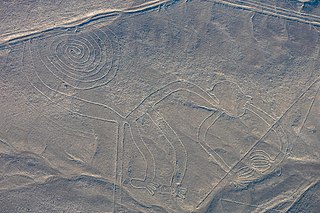 W
WThe Nazca Lines are a group of very large geoglyphs made in the soil of the Nazca Desert in southern Peru. They were created between 500 BCE and 500 CE by people making depressions or shallow incisions in the desert floor, removing pebbles and leaving differently colored dirt exposed.
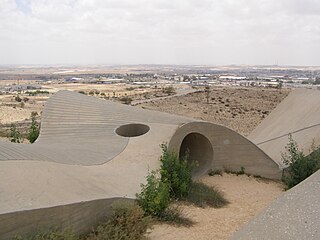 W
WThe Monument to the Negev Brigade, known locally as the Andarta, is a monument designed by Dani Karavan in memory of the members of the Palmach Negev Brigade who fell fighting on Israel's side during the 1948 Arab Israeli War. It is situated on a hill overlooking the city of Beersheba from the east and constitutes a recognized symbol of the Negev and Beersheba. In addition to its strengths as a memorial, it was a precursor to the land art movement.
 W
WThe New York Earth Room is an interior sculpture by the artist Walter de Maria that has been installed in a loft at 141 Wooster Street in New York City since 1977. The sculpture is a permanent installation of 250 cubic yards of earth in 3,600 square feet of floor space, and 22 inch depth of material. The installation has had the same caretaker, Bill Dilworth, for the past 23 years, and is maintained by the Dia Art Foundation who consider it one of their 11 locations and sites they manage.
 W
WThe Newark Earthworks in Newark and Heath, Ohio, consist of three sections of preserved earthworks: the Great Circle Earthworks, the Octagon Earthworks, and the Wright Earthworks. This complex, built by the Hopewell culture between 100 BCE and 400 CE, contains the largest earthen enclosures in the world, and was about 3,000 acres in total extent. Less than 10 percent of the total site has been preserved since European-American settlement; this area contains a total of 206 acres (83 ha). Newark's Octagon and Great Circle Earthworks are managed by the Ohio History Connection. A designated National Historic Landmark, in 2006 the Newark Earthworks was also designated as the "official prehistoric monument of the State of Ohio."
 W
WNorthumberlandia is a huge land sculpture in the shape of a reclining female figure, which was completed in 2012, near Cramlington, Northumberland, northern England.
 W
W"Not A Cornfield" was a 2005 art project that transformed a 32-acre (130,000 m2) industrial brownfield into a cornfield for one agricultural cycle. The project took place north of Chinatown.
 W
WOma forest is a work of art created by Agustin Ibarrola, a Basque sculptor and painter. The work is located in a forest near Kortezubi, in the natural reserve of Urdaibai. It is also known as the "painted forest".
 W
WOpus 40 is a large environmental sculpture in Saugerties, New York, created by sculptor and quarryman Harvey Fite (1903—1976). It comprises a sprawling series of dry-stone ramps, pedestals and platforms covering 6.5 acres (2.6 ha) of a bluestone quarry.
 W
WThe Parkfield Interventional EQ Fieldwork also known as PIEQF can be seen as the seminal work of New Zealand born installation and performance artist D.V. Rogers.
 W
WPartially Buried Woodshed is a work of land art created by American artist Robert Smithson in January 1970 at Kent State University in Kent, Ohio. The work consisted of an existing woodshed and earth added by the artist in order to illustrate the concept of entropy. By 2018, only a large mound of dirt and the structure's concrete foundation remain. The remaining elements, along with an informational plaque, are located in a small wooded area immediately behind the Liquid Crystal Institute building on the Kent State University main campus, in the southeastern area of Kent.
 W
WThe Pit is a land art project by Peter Noever in Breitenbrunn which has existed since the early 1970s and in 2019 was placed under monument protection by the Austrian Federal Office BDA.
 W
WRice paddy art is an art form originating in Japan where people plant rice of various types and colors to create images in a paddy field.
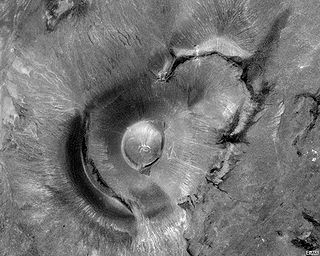 W
WRoden Crater is a cinder cone type of volcanic cone from an extinct volcano, with a remaining interior volcanic crater. It is located approximately 50 miles northeast of the city of Flagstaff in northern Arizona, United States.
 W
WThe Russian geoglyph refers to a geoglyph on slopes of the Zyuratkul Mountains in the Chelyabinsk region in Russia.
 W
WSalvation Mountain is a hillside visionary environment created by local resident Leonard Knight (1931–2014) in the California Desert area of Imperial County, north of Calipatria, northeast of Niland, near the Slab City squatter/art commune, and several miles from the Salton Sea.
 W
WSandworm (2012) is a site-specific art installation and a fusion of environmental art and architecture by Finnish architect Marco Casagrande situated on the dunes of Wenduine beach in Belgium. The curvaceous structure is made entirely from willow. The fifty-metre long organic structure stretches out between the dunes like an enormous wooden worm. It is part of the Beaufort Triennial of Contemporary art.
 W
WSite-specific art is artwork created to exist in a certain place. Typically, the artist takes the location into account while planning and creating the artwork. Site-specific art is produced both by commercial artists, and independently, and can include some instances of work such as sculpture, stencil graffiti, rock balancing, and other art forms. Installations can be in urban areas, remote natural settings, or underwater.
 W
WSpiral Island is the name of a floating artificial island built in Mexico by British artist Richart "Reishee" Sowa. It was destroyed by Hurricane Emily in 2005; a replacement, Joyxee Island, has been open for tours since 2008.
 W
WSpiral Jetty is an earthwork sculpture constructed in April 1970 that is considered to be the most important work of American sculptor Robert Smithson. Smithson documented the construction of the sculpture in a 32-minute color film also titled Spiral Jetty. Built on the northeastern shore of the Great Salt Lake near Rozel Point in Utah entirely of mud, salt crystals, and basalt rocks, Spiral Jetty forms a 1,500-foot-long (460 m), 15-foot-wide (4.6 m) counterclockwise coil jutting from the shore of the lake.
 W
WSun Farm is multidisciplinary project/place and experiential garden created by architects/artists Daniela Bertol and David Foell. The 60-acre (240,000 m2) site is located in Claverack, New York, about 110 miles (180 km) North of New York City, and includes land art constructions, geoglyphs, architectural fabrications and sculptures:
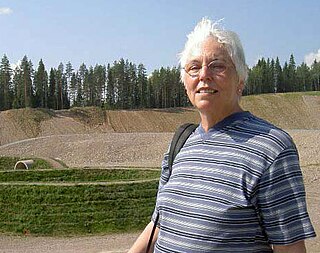 W
WNancy Holt was an American artist most known for her public sculpture, installation art, concrete poetry, and land art. Throughout her career, Holt also produced works in other media, including film and photography, and wrote books and articles about art.
 W
WTroublemakers: The Story of Land Art is a 2015 American documentary film directed by James Crump. Troublemakers chronicles the history of land art in the 1960s and 1970s, when a group of radical New York artists began producing earthworks on a monumental scale in the desert spaces of the American southwest. The film follows the enigmatic careers of artists who use the earth itself as their primary medium, including Robert Smithson, Walter De Maria and Michael Heizer.
 W
WVintondale is a borough in Cambria County, Pennsylvania, United States. It is part of the Johnstown, Pennsylvania Metropolitan Statistical Area. The population was 414 as of the 2010 census.